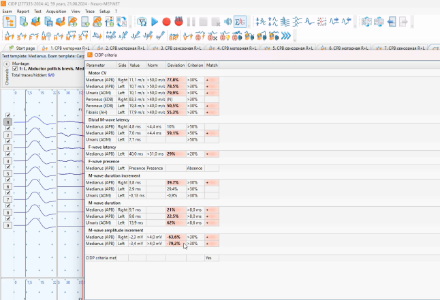CIDP (chronic inflammatory demyelinating polyneuropathy) is a peripheral nerve disorder characterized by the gradual development of weakness and numbness in the extremities. The main mechanism of the disease is autoimmune damage to myelin.
In 2021, the European Academy of Neurology/Peripheral Nerve Society (EAN/PNS) group of experts published guidelines for the diagnosis and treatment of this disease.
One of the diagnostic criteria for CIDP is the presence of reliable signs of demyelination according to EMG data. These signs include a decrease in the speed of motor conduction along the nerve, an increase in distal latency, an increase in the minimum latency of F-waves or their absence, the presence of conduction blocks or temporal dispersion, and an increase in the duration of the M-response when stimulated at distal points. The deviation of each parameter must be at least a certain percentage (for each of its own), deviations must be detected in two or more nerves. Some signs are not independent and require additional signs in other nerves. In addition, there are additional conditions that depend on the amplitude of the motor response.
After performing the examination, the doctor should correlate all the detected changes, make calculations and make a conclusion whether the detected changes correspond to reliable signs of demyelination. In fact, it is not easy to keep such a large number of parameters and their deviations in mind at the same time, and calculations take a lot of time. So in the program Neuro-MEP.NET automatic accounting of reliable demyelination criteria was implemented, according to the EAN / PNS guideline for the diagnosis and treatment of CIDP from 2021.
The algorithm takes into account the following parameters:
- distal latency of the motor response when recording from the Extensor digitorum brevis, Abductor hallucis, Abductor digiti minimi, Abductor policis brevis muscles;
- motor conduction velocity, conduction blocks, temporal dispersion at the forearm level when examining the median and ulnar nerves, at the shin level when examining the tibial and peroneal nerves when conducting from the above-mentioned nerves
- the minimum latency of the F-wave, the presence of F-waves when registering them from the above-mentioned muscles;
- the duration of the M-response when registering from the above-mentioned muscles is also taken into account.
The algorithm applies criteria depending on the amplitude of the motor response, since some parameters depend on the degree of its decrease. The algorithm does not take into account the above-described parameters in the proximal areas and when withdrawing from the proximal muscles.
All you need to do is select the demyelination criteria option from the View menu at the end of the examination. Once you do that, a window will open, displaying the parameters obtained during the survey. These parameters are then used in the algorithm described earlier. The window also shows any deviations from the established criteria and whether they meet the criteria for reliable demyelination of EAN/PNS 2021. At the bottom of the table, you'll see a conclusion about whether the identified changes meet the criteria for a reliable diagnosis of EAN/PNS according to the 2021 standards.
Please note that meeting the demyelinization criteria does not mean that the patient necessarily suffers from CIDP. In addition to this feature, the website also describes other criteria necessary for diagnosis. Other diseases, such as NMHC type 1, may also meet the criteria for demyelinization of EAN/PNS. Therefore, the diagnosis of CIDP cannot be based on the EMG data only.
Also, the EAN/PNS 2021 guideline describes the features of conducting an EMG study and methodological recommendations. We strongly advise you to read them before using this tool.
Our EMG systems have a wide range of functions for performing various tasks and are in demand all over the world for their high signal quality, functionality and convenience. If you would like to purchase our equipment or ask a question to Neurosoft specialists, please contact the sales department by phone +7 4932 95-99-99 or by e-mail info@neurosoft.com.
DOI: 10.1111/jns.12455
